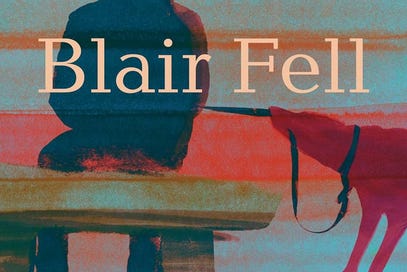This post uses the usual linguistic convention, which is to write “deaf” to refer to audiological hearing loss and use “Deaf” to refer to people who are part of Deaf culture, which includes all those for whom American Sign Language (ASL) is a native or primary language. The use of “d/Deaf” is meant to include both groups. As a deaf person who knows some ASL but is far from fluent in it, I am deaf but not Deaf.
Last week, I went to Montpelier as part of my Vermont 251 series. One of my checklist of goals for that project is to shop in a locally-owned establishment, at least some of the time.
Montpelier supports not one but two independent bookstores, which is borderline miraculous in 2025 for anywhere that isn’t a big city — much less a tiny little town of 8,000 people.
I wandered into both, and within two minutes of browsing, this novel jumped off the shelf at me. The word sign in the title caught my eye instantly. Novels with d/Deaf or terp characters are always a good time for any deaf person. (“Terp” is short for interpreter.)
I’d been integrating into the Mississippi d/Deaf community when I moved to New England and, thanks to the largesse of blue-state Medicaid, finally got powerful hearing aids, and with them a normal life (provided the power stays on for recharging). Back then, I was far from fluent in ASL, and now I’m basically an extremely rusty intermediate signer. But I spent enough time in that world to understand it. I miss signing1. And I love novels that portray that community well.
All of this makes such novels incredibly hit-or-miss — a bimodal distribution of “Oh my God, yes” or “FFS, who let you write this?”
This one had two clear ways to disappoint me: it’s told in alternating perspectives — one, a DeafBlind Jehovah’s Witness man; the other, a terp who’s only ever worked with Deaf clients before. The way DeafBlind communicate, tactile ASL, is new to him. In tactile ASL, the terp reads the client’s signing in the usual way, but speaks to the client by placing his/her hands into the client’s hands before replying. That way the client can feel what the terp is signing. Many aspects of DeafBlind lives are unfamiliar to me, but the cultural overlap between the DeafBlind and the Deaf is substantial, as they use the same language.
So it had two landmines waiting to go off: cult childhood experience, of which I have my share, and the reality of navigating the world without all five senses.
It only stepped on one. Briefly, near the end. The rest of it? Remarkably good.
One of the things it gets gloriously right is a running joke — but an accurate one — about the four main types of people who become ASL interpreters:
1. CODAs (Children of Deaf Adults) — ASL is their first language, so interpreting is just getting paid to speak their native tongue and stay rooted in their home culture.
2. Religious zealots — ASL is a means of evangelism. Most Deaf people are born to hearing parents who never bother to learn to sign. The result is language deprivation and serious attachment trauma. That combination makes them prime recruits for tight-knit religious communities eager to offer belonging and certainty.
3. Brainy progressive women — ASL is a complex, evolving language, and Deaf culture comes with its own fast-shifting norms. For women who want to keep their IQs sharp while also social justicing all over the place, it’s a two-for-one deal.
4. Queers — As the gay terp in the novel points out, the appeal here is twofold: outsiders are drawn to outsiders2, and interpreting offers a kind of freewheeling autonomy that suits many queer people. A medical appointment one day, a courtroom hearing the next, then a semester-long gig where you get to audit US History, English lit, or Sociology right alongside the client.
It’s both funny and dead-on. When a terp shows up from an agency, you never quite know what you’re going to get. The categories are loose, sure — a CODA can also be a progressive activist, or a queer ex-Mormon who now teaches yoga to toddlers. But the real fun is in trying to guess, based on the outfit.
Sometimes you get a 40-year-old woman in a long skirt and a Peter Pan collar who looks like she homeschools her twelve children and bakes communion bread from scratch — and yep, that’s your Jehovah’s Witness terp. Other times, it’s a pink-haired “nonbinary” person in a mesh shirt and a dog collar, sipping yerba mate out of a mason jar — and that’s your terp for your physical therapy appointment.
You learn not to assume anything.
But you also learn: the weirder the outfit, the more likely they are to be really good.
Keep reading with a 7-day free trial
Subscribe to Holly’s Substack to keep reading this post and get 7 days of free access to the full post archives.




